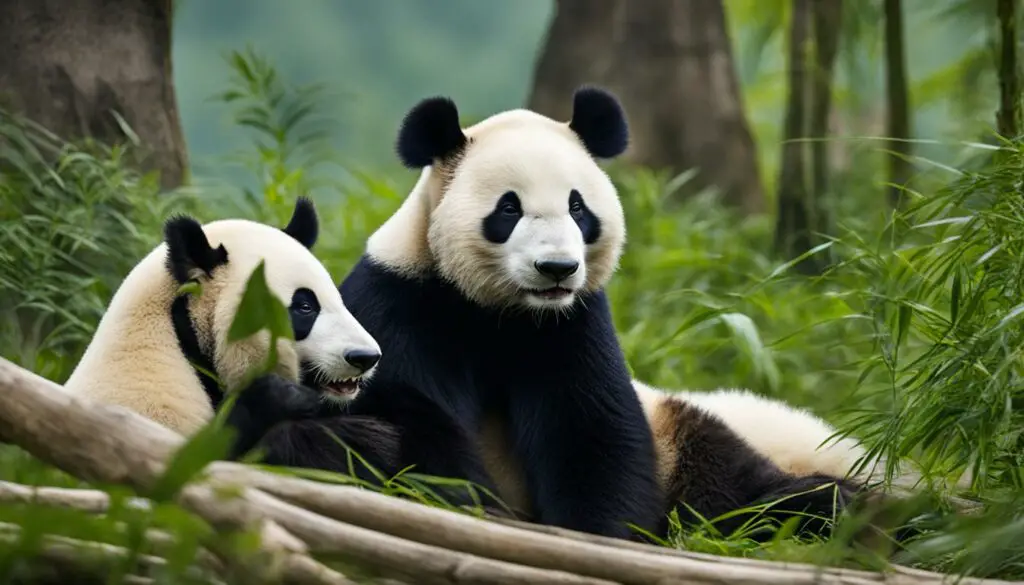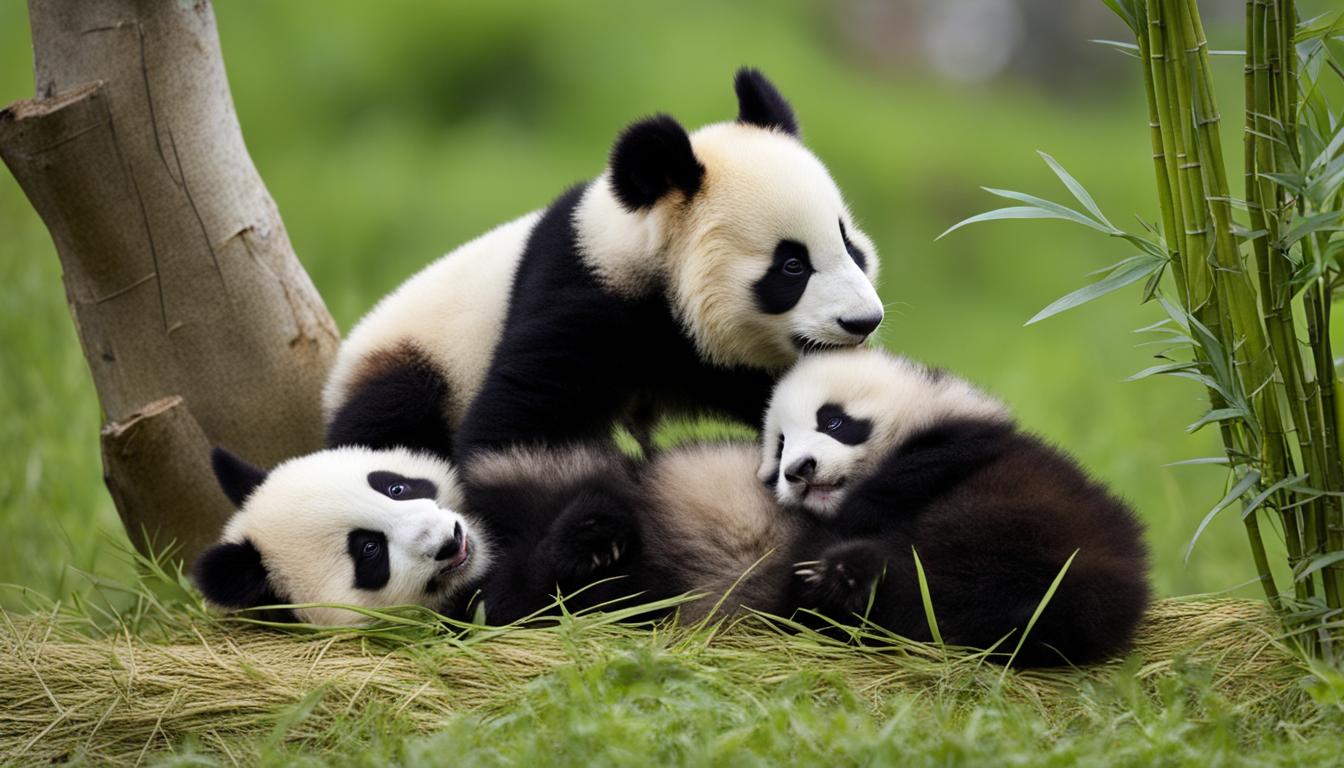Welcome to our article on the fascinating journey of giant panda cubs! If you’re a fan of adorable pandas, you’re in for a treat. In this section, we’ll explore the incredible growth and development of panda cubs, from their humble beginnings to their independent and playful nature.
But first, let’s take a moment to appreciate the cuteness of these baby pandas. Just imagine those tiny pink and white bundles of joy, weighing only a few ounces, born into a world of black and white. We can’t help but smile at their adorableness!
Now, let’s dive into the details of how these incredible creatures grow and thrive. Get ready to be amazed by their rapid progress and the challenges they face along the way. So, buckle up and join us on this heartwarming journey of panda cub development!
The Fragility of Panda Cubs in the Wild
Giant panda cubs, weighing only about 100g or 4 ounces, are incredibly small and fragile when they are born. Unlike other animals, they are almost unrecognizable at birth, with pink skin and sparse white hair. This vulnerability makes them highly dependent on their mothers for their survival. Cubs rely solely on their mother’s milk for nutrition and are vulnerable to predators in the wild. Due to these challenges, pandas are considered an endangered species and require dedicated conservation efforts to protect their populations.
The fragility of panda cubs is evident in their early stages of development. At birth, they are so tiny that their mother has to provide constant care, including stimulating their urination and defecation by rubbing their bellies. Cubs are unable to defend themselves and rely on their mother’s protection until they are able to gain independence. The fragility of panda cubs emphasizes the need for conservation efforts to ensure their survival and the preservation of their habitats.
The conservation of panda populations is crucial for their long-term survival. Efforts to protect these endangered species involve the preservation and restoration of their natural habitats, as well as the establishment of breeding programs to increase their numbers. By focusing on conservation, we can help mitigate the threats faced by panda cubs in the wild and ensure a future where these adorable creatures can thrive.
| Conservation Efforts for Panda Cubs | How It Helps |
|---|---|
| Preservation and restoration of natural habitats | Provides a safe and suitable environment for pandas to live and breed |
| Establishment of breeding programs | Increases the population of pandas to enhance genetic diversity and reduce the risk of extinction |
| Public awareness and education | Encourages people to support conservation efforts and make sustainable choices |
“Conservation is the key to securing the future of endangered species like pandas,” says Dr. Lisa Johnson, a wildlife conservation expert.
“By protecting their natural habitats and implementing effective conservation strategies, we can ensure that future generations will have the opportunity to witness the beauty and wonders of these incredible creatures.”
The Rapid Growth of Panda Cubs
Panda breeding programs play a vital role in ensuring the survival and growth of panda populations. These programs focus on providing the necessary care and resources for panda cubs to experience rapid growth and development. Within 48 hours of being born, panda cubs undergo a remarkable transformation. Their pink skin is covered with white fur, and black markings start to appear, distinguishing them as adorable panda cubs.
As they grow, panda cubs rely on their mother’s milk, which is rich in fat and provides essential nutrients for their rapid growth. They suckle up to 14 times a day, quickly gaining weight. By the time they reach one year old, they can weigh about 45 kg (100 lb), showcasing their astonishing growth rate.
To further illustrate the rapid growth of panda cubs, let’s take a look at the following table:
| Age | Weight |
|---|---|
| 2 months | 5 kg (11 lb) |
| 6 months | 20 kg (44 lb) |
| 1 year | 45 kg (100 lb) |
This table clearly demonstrates the significant weight gain of panda cubs in just a few months. It is through the dedication of panda breeding programs and their understanding of panda habitat and needs that these remarkable growth rates can be achieved.
The Journey to Adulthood for Panda Cubs
As panda cubs reach five months old, they embark on an exciting journey to adulthood. At this stage, they start gaining independence from their mother and begin exploring the world outside their dens. With their eyes fully open and their bodies growing stronger, they take their first steps, wobbling and stumbling as they learn to walk.
The cubs’ curiosity leads them to venture further, testing their newfound abilities to climb trees and navigate their surroundings. They become more adventurous in their exploration and start sampling solid foods, particularly bamboo, which becomes a staple of their diet. This transition from solely relying on their mother’s milk to consuming solids marks a significant milestone in their development.
Over the next year, panda cubs engage in play and interaction with their siblings, honing their social and physical skills. They engage in friendly wrestling matches, chase each other through the bamboo forests, and learn essential survival techniques from their mother. These experiences prepare them for the challenges they will face as adults.
The Role of Captivity
In captivity, panda cubs receive specialized care and attention to ensure their healthy growth and development. They are often trained for various activities, including health examinations and eventual relocation to breeding programs in China. These measures aim to support the conservation efforts for this endangered species and increase their chances of survival in the wild.
In conclusion, the journey to adulthood for panda cubs is an exciting and crucial phase in their lives. It is a time of exploration, learning, and growth as they gain independence from their mother and develop the necessary skills for adulthood. Whether in the wild or in captivity, panda cubs captivate us with their adorable behavior and remind us of the importance of protecting and preserving these remarkable creatures.
| Key Behaviors of Panda Cubs on Their Journey to Adulthood: |
|---|
| Exploring the world outside the den |
| Learning to walk and climb trees |
| Transitioning to solid foods, particularly bamboo |
| Engaging in play and interaction with siblings |
| Receiving specialized care and training in captivity |
Reproduction and Life Cycle of Giant Pandas
The reproduction and life cycle of giant pandas play a crucial role in the survival and conservation efforts of this adorable species. Female giant pandas typically reach maturity at around four to six years old, while males mature a bit later at six years old. It is during this time that the panda breeding process begins.
Female pandas are only fertile for a short period each year, usually in the spring. Once they conceive, they undergo a gestation period of three to five months, typically giving birth to a single cub. While twin births are possible, it is common for the mother to focus on one cub and abandon the other due to the challenges of raising multiple offspring.
After birth, the panda cubs are born tiny and helpless, weighing only about 100g or 4 ounces. They rely solely on their mother’s milk for nutrition and require constant care and protection. As they grow, panda cubs experience rapid growth, reaching a weight of about 45 kg (100 lb) by one year old.
| Life Stage | Description |
|---|---|
| Birth to 2 months | Cubs are pink and weigh 3-5 ounces. Their eyes are tightly shut, and they are covered in sparse, short white hairs. |
| 2 months to 5 months | Eyes fully open, cubs can stand and walk a few steps. They develop black patches around the eyes, ears, shoulders, and legs. |
| 5 months to 2 years | Cubs gain independence and start living independently. They learn to walk, climb, and eat solid foods like bamboo. |
| 2 years and beyond | Panda cubs are ready for adulthood and leave their mother to establish their own territory. |
Giant pandas have a lifespan of up to 30 years in captivity, while in the wild, their lifespan is around 20 years. Understanding the reproduction and life cycle of giant pandas is essential for ensuring their conservation and preservation. Through panda breeding programs and ongoing efforts to protect their natural habitat, we can secure a future for these extraordinary creatures.

Conclusion
Panda cubs go through an incredible journey of growth and development, from being born tiny and helpless to becoming independent and ready for adulthood. These adorable creatures captivate our hearts with their unique characteristics and charm. However, their fragility in the wild highlights the urgent need for panda conservation efforts.
Conservation initiatives play a crucial role in protecting the future of giant pandas. Through the establishment of panda breeding programs and the preservation of their natural habitat, we can ensure the survival of this endangered species. By supporting panda conservation, we contribute to the preservation of not only their adorable presence but also the diversity and balance of our ecosystem.
Understanding the life cycle of giant pandas allows us to appreciate the challenges they face and the importance of their conservation and preservation. By working together, we can make a difference in securing a bright future for these incredible creatures. Let’s cherish and protect these adorable pandas for generations to come.
What are the similarities and differences in the growth and development of giant panda cubs and baby koalas?
The baby koala growth and development differ from giant panda cubs in several ways. Both start as tiny, hairless creatures, but baby koalas rely solely on their mother’s milk for the first six months, while giant panda cubs start to eat bamboo after about six months. Additionally, giant panda cubs grow much larger than baby koalas.
FAQ
How do giant panda cubs grow and develop?
Giant panda cubs are born pink and weigh only three to five ounces, about 1/900th of their mother’s weight. They develop black patches around the eyes, ears, shoulders, and legs as they grow. By five months old, they can trot behind their mother, climb trees, and eat solids.
What challenges do panda cubs face in the wild?
Panda cubs are born tiny and vulnerable, relying solely on their mother’s milk for nutrition. They face the risk of predators and have low birth rates, making them an endangered species. Conservation efforts are crucial for their survival.
How quickly do panda cubs grow?
Within 48 hours, panda cubs’ pink skin is covered in white fur and they develop black markings. They gain weight quickly and can weigh about 45 kg (100 lb) at one year old, thanks to the high-fat milk provided by their mother. Panda breeding programs aid in their growth and survival.
When do panda cubs become independent?
Panda cubs start gaining independence at around five months old. They leave their dens, learn to walk, climb, and eat solid foods like bamboo. At one and a half to two years old, they are ready to live independently. In captivity, they may be trained for health examinations and relocation.
How do giant pandas reproduce?
Female giant pandas can breed at four to six years old, while males mature at six years old. They are fertile for a short period each year. Cubs are born after a gestation period of three to five months and are usually born in the late summer. Giant pandas can live up to 30 years in captivity and around 20 years in the wild.











